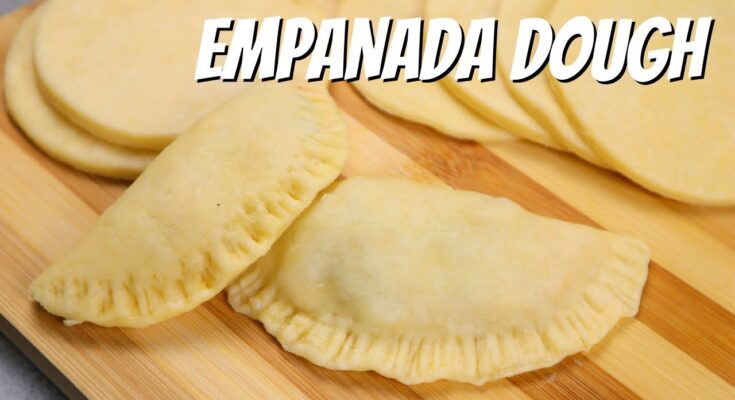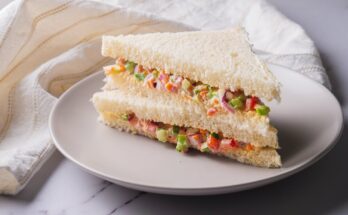Empanada Dough Recipe: Empanadas are delicious, hand-held pastries filled with sweet or savory ingredients, wrapped in a golden, flaky crust. The secret to perfect empanadas? The dough.
A well-made empanada dough should be tender yet sturdy enough to hold the filling without breaking. It should also have the right balance of flavor, whether you choose a buttery, flaky texture or a crispier, firmer bite.
This guide will show you how to make homemade empanada dough that works for both baked and fried empanadas. Let’s get started!
Types of Empanada Dough
There are two main types of empanada dough, and each has its own unique characteristics:
Baked Empanada Dough
- Made with butter or oil
- Produces a flaky, pastry-like crust
- Best for oven-baked empanadas
Fried Empanada Dough
- Often made with lard for a crispier texture
- More elastic, preventing breakage during frying
- Creates a golden, crunchy shell
Traditional vs. Modern Variations
While traditional empanada dough uses flour, fat, water, and salt, modern recipes might include eggs, baking powder, or even milk to achieve different textures.
Ingredients Needed for Empanada Dough
To make perfect empanada dough, you’ll need:
Basic Ingredients
- 2 ½ cups (315g) all-purpose flour – Provides structure
- ½ cup (115g) unsalted butter or lard, chilled and cubed – Adds flakiness
- 1 teaspoon salt – Enhances flavor
- ½ teaspoon sugar (optional) – Balances taste
- ⅓ cup (80ml) cold water – Helps form the dough
- 1 egg (optional, for richness)
Optional Add-ins for Flavor
- 1 tablespoon vinegar or lemon juice – Improves dough texture
- ½ teaspoon baking powder – Creates a lighter crust
- Milk instead of water – Adds tenderness
Kitchen Tools Required
Before we begin, make sure you have the following tools:
- Mixing bowl – For combining ingredients
- Pastry cutter or fork – To blend butter into flour
- Rolling pin – To flatten the dough evenly
- Round cutter (or a glass) – To cut empanada circles
- Plastic wrap – To rest the dough
Step-by-Step Instructions to Make Empanada Dough
Step 1: Mixing the Dry Ingredients
In a large mixing bowl, whisk together the flour, salt, and sugar (if using).
Step 2: Incorporating the Fat
- Add the cold butter or lard to the flour.
- Use a pastry cutter or your fingers to mix until it resembles coarse crumbs.
Step 3: Adding Liquid and Forming the Dough
- Gradually add the cold water (and egg if using), mixing with a fork until the dough comes together.
- Knead gently on a floured surface until smooth (about 2-3 minutes).
Step 4: Resting the Dough for Elasticity
- Wrap the dough in plastic wrap and refrigerate for at least 30 minutes.
- This helps the gluten relax, making it easier to roll out.
How to Roll and Cut the Dough
Once your dough has rested, it’s time to roll it out and cut perfect empanada circles.
Rolling Techniques
- Lightly flour a clean surface and your rolling pin to prevent sticking.
- Roll out the dough evenly to about ⅛ inch (3 mm) thick.
- If the dough resists or shrinks back, let it rest for another 5-10 minutes before rolling again.
Cutting Perfect Circles
- Use a round cutter (4-5 inches in diameter) or a large drinking glass to cut out circles.
- If you don’t have a round cutter, you can use a small bowl and trace with a knife.
- Gather the dough scraps, knead briefly, re-roll, and cut more circles.
Now, you have the perfect empanada dough discs ready to be filled!
Filling and Sealing the Empanadas
Proper Filling Proportions
- Don’t overfill! Use about 1-2 tablespoons of filling per empanada.
- If using juicy fillings, drain excess liquid to prevent soggy dough.
How to Seal the Empanadas
- Fold the dough over the filling to form a half-moon shape.
- Press edges together firmly with your fingers.
- Crimping techniques:
- Fork method: Press the edges with a fork for a simple seal.
- Traditional repulgue (twist fold): Fold and twist the edge for a decorative, tight seal.
- For extra security, brush the edges with a little water or beaten egg before sealing.
Baking vs. Frying the Empanadas
Baking Method
- Preheat oven to 375°F (190°C).
- Place empanadas on a parchment-lined baking sheet.
- Brush with egg wash (1 beaten egg + 1 tablespoon water) for a golden crust.
- Bake for 20-25 minutes or until golden brown.
Frying Method
- Heat 2 inches of oil in a pan to 350°F (175°C).
- Fry empanadas in batches for 2-3 minutes per side, until golden.
- Drain on paper towels before serving.
Tips for the Best Empanada Dough
- Use cold ingredients: This keeps the dough flaky and prevents toughness.
- Don’t overwork the dough: Over-kneading leads to tough empanadas.
- Let the dough rest: This relaxes the gluten, making it easier to roll out.
- Chill before baking or frying: This prevents the dough from becoming too soft.
Variations of Empanada Dough
Whole Wheat Dough
- Substitute half or all the all-purpose flour with whole wheat flour.
- Add an extra 1-2 tablespoons of water since whole wheat absorbs more moisture.
Gluten-Free Alternative
- Use a gluten-free flour blend with xanthan gum for elasticity.
- Add 1 teaspoon of vinegar for better texture.
Storage and Freezing Tips
How to Store Raw Dough
- Wrap the dough tightly in plastic wrap and refrigerate for up to 2 days.
Freezing and Thawing Methods
- Freeze dough: Wrap in plastic, place in a freezer bag, and store for up to 3 months.
- Freeze unbaked empanadas: Arrange on a tray, freeze, then transfer to a bag.
- Thaw overnight in the fridge before rolling out or baking.
Serving Suggestions
Best Dips and Sauces
- Chimichurri: A tangy Argentine herb sauce.
- Salsa Roja: A spicy red tomato sauce.
- Aioli: A garlicky mayonnaise dip.
Pairing with Side Dishes
- Salad: A fresh, light salad balances the richness.
- Rice & beans: A classic Latin American combo.
FAQs about Empanada Dough Recipe
What type of flour is best for empanada dough?
For empanada dough, all-purpose flour is most commonly used because it creates a balanced texture that’s neither too tough nor too flaky. However, you can also use bread flour for a chewier texture or pastry flour for a flakier crust.
Can I make empanada dough without eggs?
Yes, you can make empanada dough without eggs. Simply omit the eggs and ensure your dough has enough moisture from other ingredients like butter or water. This variation might affect the texture slightly, making the dough less rich.
Is it necessary to chill the dough before using it?
Chilling the dough before rolling it out is highly recommended. This step solidifies the fat in the dough, making it easier to handle and helping to prevent the dough from shrinking when baked or fried.
Can I use a food processor to make the dough?
Absolutely! A food processor can quickly bring together the dough ingredients, making the process easier and faster. Just be careful not to overmix, as it can lead to a tough dough.
How long can I store empanada dough in the refrigerator?
Empanada dough can be stored in the refrigerator for up to three days, tightly wrapped in plastic wrap. This makes it convenient to prepare the dough in advance.
Can empanada dough be frozen for later use?
Yes, empanada dough freezes well. Wrap the dough tightly in plastic wrap and then place it in a freezer bag. It can be stored in the freezer for up to three months. Thaw in the refrigerator overnight before using.
What are some common fillings for empanadas?
Popular fillings include seasoned beef, chicken, cheese, and vegetables. For a sweet variation, you can fill empanadas with fruit, jam, or dulce de leche.
Is it better to bake or fry empanadas?
Whether to bake or fry empanadas depends on personal preference. Baking offers a lighter, crisp finish, while frying gives a golden, crispy exterior with a rich flavor.
Conclusion
Making homemade empanada dough is simple, rewarding, and allows you to create the perfect base for any filling. Whether baked or fried, this versatile dough ensures delicious, flaky empanadas every time. With the right techniques and ingredients, you’ll master empanada dough in no time!
Now that you have the perfect dough, all that’s left is to fill, seal, and cook your empanadas. Enjoy!



